by Winding Pathways | Jun 8, 2023 | Garden/Yard, Nature, Pests
A “Hard Knock Life”
A tick’s life is hard. I’m hungry. I am a tick and I’ve been waiting a week for a juicy raccoon, dog, or wild turkey to walk by. Even a mouse would be welcome.
So far, no luck. I know a tick’s best bet for grabbing a passing animal is the “questing” position, so I’ve been hanging on to a branch with both pairs of my hind legs. My front pair of legs sticks out into the path ready to grab the fur or feathers of a passing animal. So far, no animal. Patience is hard and I’m hungry.
Larval Luck
I was luckier last year when I was a larva. I was hungry then, too, but the wait was short. A big, furry animal humans call a dog ambled by. Even though I only had six legs then I was able to grab a hold, and the rest was easy. I crawled around exploring under the fur until I found a spot with soft thin skin, dug in, and chowed down. Boy was that blood tasty! It was so nutritious that I left my host to grow and graduate. I’m now a tick nymph, complete with eight legs, but I need more blood to transform into an adult.
I’m still hungry. As I sit waiting, I admire the mosquitoes and flies that buzz by over my perch. They don’t need to be patient but can fly and search for a blood-rich victim. I can’t fly or jump, so all I can do is patiently wait until something walks by. I hope that’s soon because many of my fellow ticks starve.
Attracted to Carbon Dioxide and Moisture
What’s this? I sense a bubble of carbon dioxide and moisture. Might be the breath of an animal. Now I feel the vibration of footsteps. Must be a big animal. My front legs are outstretched in anticipation and I’m not disappointed.
I grab hold of a strange animal. It’s tall with only two legs. No hair. No feathers. Just some sort of covering over thin skin. No chance of biting through it, but I got a good grip on that covering and started climbing using all of my eight legs. Soon I was under what humans call pants and kept exploring and climbing. Bingo, I found a nice moist spot where my blood dinner was just beneath thin skin. I got ready to feast.
Then something happened. I should be happy with a meal so close at hand. Instead, I felt sick. My legs wouldn’t hold on and I dropped to the ground lifeless.
About Ticks
Pity the poor tick the above. Well, maybe not. It’s hard to pity an animal that can spread disease and discomfort. Ticks usually feed on mammals, birds, and even reptiles but if none come around, human blood suits them just fine.
Ticks are effective disease spreaders because of their relatively long life which can extend for two or three years and their habit of eating a blood meal during different life stages. This enables them to bite one animal carrying a disease in its blood and inject it into a different animal during a later feeding.
Seriously Avoiding Ticks
At Winding Pathways, we take ticks seriously. Rich has had Lyme disease twice, fortunately successfully cured by strong antibiotics. Other people are not as lucky and experience long-term symptoms. And, Lyme is not the only disease ticks spread.
Understanding ticks and taking precautions reduces the odds a person will be bitten and contract a disease from them.
How ticks Operate
Ticks are ambush hunters. As the tick describes above, they wait for a victim to pass within grabbing distance of their front legs. Often ticks walk around on their victim for several hours before they dig through the skin and help themselves to a blood meal.
In order to contract a tick-borne disease a victim must be bitten, so a walking tick won’t transmit illness.
Reduce Your Odds
We often explore the woods, work in our yard and garden, and generally spend time in tick country. Here are precautions we take that reduce the odds of a tick bite:
- We spray our outdoor clothes and shoes with permethrin. It lasts for several washings and kills ticks. The hapless tick described above fell victim to this chemical.
- We often tuck our pants legs into our socks, sprayed with permethrin, to make it hard for any tick that gets on our socks or pants to get under them.
- After returning to the house, we disrobe and shower after we have checked for ticks. They prefer moist dark body areas so we especially check those places. Clothing goes into the washer.
- We watch for symptoms of Lyme Disease, especially a rash and fatigue. If they appear we call our physician immediately.
Promising Product
A few years ago, Rich was so determined to prevent another Lyme Disease incident that he invested in socks, pants, and shirts from Insect Shield. The company infuses its clothing with permethrin that, they claim, is effective for at least 70 washings.
Does this chemical work? Is Insect Shield clothing worth buying? Well, since wearing it Rich hasn’t found a tick on him and he’s been free of Lyme Disease. That’s not a scientific verdict but it’s good enough for him to keep wearing the clothes.
-
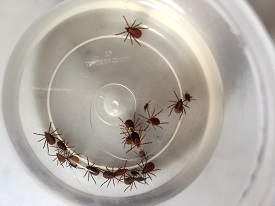
-
Tiny ticks can cause problems, so we go prepared in nature.
-
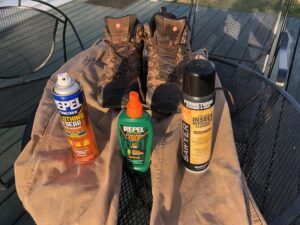
-
Pants, boots, varied sprays can reduce odds of picking up ticks
-
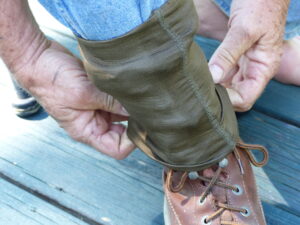
-
gaiters with tick guard helps repel ticks.
-
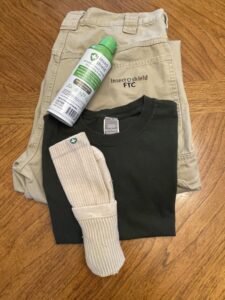
-
Pants, shirts, and socks infused with permethrin appear to keep ticks off.
Disclaimer
Rich purchased his Insect Shield clothing at the retail price. He’s still testing them but they seem to work. Winding Pathways was not paid for this blog.
by Winding Pathways | Apr 16, 2020 | (Sub)Urban Homesteading, Garden/Yard, Nature, Pests
Lyme Disease is something you just don’t want. Rich has had it twice. It was no fun, and he was lucky. Nearly as soon as symptoms appeared, he visited our family physician. She prescribed a powerful antibiotic that worked wonders and left him with no lingering problems. Unfortunately, many Lyme Disease victims suffer pain and fatigue for years. It’s serious.
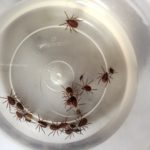
Collection of ticks
Lyme is often transmitted to a human from a bite by a tiny tick that picked up the disease bacteria from an infected white-footed mouse. It once was thought that deer were the primary carrier but mostly they are host to a tiny larval tick that infects a mouse that allows another tick to infect a person.
In theory, eliminating white-footed mice from a yard and home will greatly reduce the odds of transmission of this disease to people. Killing all of them isn’t feasible but reducing their numbers is.
About White-Footed and Deer Mice
White Footed and Deer Mice are amazingly common across much of North America. They’re the cute, native mouse, not to be confused with the common house mouse that originated in the Old World.
White Footeds naturally live in dry temperate forests with brush. That perfectly describes suburban landscaping. It’s likely that five to 20 white-footed mice live in close proximity to most suburban families. They’re nocturnal and rarely seen.
Here are some characteristics:
- They’re hoarders. Find a cache of corn, dog food, or acorns in a shoe or empty can and you’ve found a white-footed mouse cache.
- They reproduce like crazy. A 44-day old female can become pregnant and bear a litter after 22 to 28 days. Babies become independent in three weeks and soon begin having their own babies. Mom often has two to four litters a year.
- They don’t live long. A year-old mouse is elderly.
- Foxes, weasels, hawks, owls, coyotes, and many other predators love dining on mice.
- White Footed mice enjoy coming into homes, where they often find food and enjoy a furnace’s warmth. They can bring with them disease-bearing ticks.
Prudent homeowners carefully manage ticks, in part by reducing white-footed mice numbers. The fewer mice that live near people the lower the odds a person will contract Lyme Disease. So, managing mice and ticks makes for a healthier home and yard. Here are a few tips:
To reduce mouse populations and entry to homes:
- Welcome mouse predators. Karla Bloem, Executive Director of the International Owl Center says, “Two actions people can take to encourage owls are to protect large dead trees that aren’t a threat to people of buildings should they fall. Owls love them. Also, building and erecting an owl house can welcome owls to live near a home and catch and eat mice.” Barred owl nest box plans, and plans for many other birdhouses, can be found at www.nestwatch.org.
- Plug up holes that allow mice to enter a home and replace worn or broken weatherstripping. This is an important fall maintenance that also keeps cold drafts outside and reduces heating bills.
- Avoid feeding mice. They love dining on dog or cat food left in a dish overnight or birdseed left under a feeder. Only feed pets and wild birds what they can eat in a short time. Then, pick up and clean the pet bowl.
- Use snap traps to kill mice in the house. Avoid poison. A poisoned mouse can stagger outside to be caught and eaten by an owl, which can sicken or die from the poison.
A Few More Ways to Reduce Lyme Disease
In addition to reducing mouse numbers and applying a vaccine to keep survivors free of Lyme Disease bacteria here are a few other ways a person can do to reduce odds of infection:
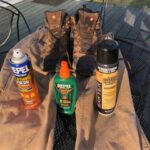
Pants, boots, gaiters and insect repellents help protect from ticks.
Use Permethrin: When applied to clothing, not skin, this chemical repels and kills ticks. Rich purchased several sets of clothing from the Insect Shield Company that are impregnated with permethrin. Supposedly the tick-killing effectiveness lasts for 70 washings. The chemical is also available in spray cans to apply to any clothing.
Do Tick Checks: After being outside, strip down and check the body over for ticks. Then take a hot sudsy shower. Ticks usually crawl around on a person for several hours before biting. A tick merely walking on the skin can’t infect a person.

Opossums groom themselves carefully.
Thank and welcome opossums: New research indicates that opossums are tick vacuum cleaners. Ticks climb on them, but these primitive mammals groom often and eat the ticks they remove from their fur and skin. If you have a possum living in the yard be happy.
An Emerging Tool in the Battle Against Lyme Disease
A new product is being developed and tested by a major research company. It is an oral nontoxic vaccine placed in small baits. When strategically positioned around a yard, mice not yet infected with Lyme bacteria eat it and become resistant to the bacteria. Mice uninfected by Lyme can’t spread the disease to a person. If all goes well this product will be on the market by 2021 and may be a major help in reducing human cases of Lyme Disease.
Lyme Disease is an awful condition. Taking precautions to reduce the odds of being infected makes sense.
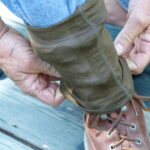
gaiters with tick guard help repel ticks.
by Winding Pathways | Aug 23, 2018 | Pests
Lyme Disease Has Spread
According to National Public Radio physicians in all 50 states have reported treating cases of Lyme Disease. It is named for the town of Lyme, Connecticut, where it was first identified in the 1970s.
At first, the disease was confined mostly to the Eastern States and parts of the upper Midwest, but it has since spread widely, and the Center for Disease Control considers it one of the fastest spreading vector-borne diseases. Lyme Disease can cause fatigue, joint pain, and serious long-term problems. It is spread to people bitten by a tick so tiny that often the victim never sees it.
What’s Up With the Fatigue?
Rich contracted Lyme Disease in 2015 and again in 2018 and was successfully treated by Cedar Rapids Physician, Mary Anne Nelson, both times. His experience may help anyone who may have contracted the disease enjoy recovery from the disease. A major symptom can be fatigue.
“In 2015 I felt utterly fatigued for weeks on end. I never saw a tick or had a rash so didn’t suspect Lyme Disease. Because I wasn’t terribly sick I delayed going to Dr. Nelson until I started having knee joint pain. She prescribed a blood test that was positive for Lyme and treated it with powerful antibiotics. Fortunately, the medication worked, I had no side effects from the medication, and after a couple of months my energy returned as the joint pain faded,” he said.
Return of Lyme Disease
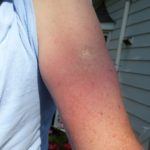
A common symptom is a generalized rash that is warm to the touch.
In 2018 a pinkish rash appeared on Rich’s left shoulder along with shoulder joint pain.
He immediately visited Dr. Nelson. She prescribed antibiotics, skipping the blood test. Symptoms vanished in a few weeks.
Not all Lyme victims are as fortunate as Rich and many struggle with the disease for years. Anyone who experiences the symptoms of rash, joint pain, or lethargy, even if they don’t feel terribly sick, should get to their physician right away. Early treatment may be most effective.
Hard to Detect
According to Dr. Nelson, Rich’s second round of Lyme was fairly typical. Like him, many victims are unaware they were bitten by a tick and often a pink rash is more common than the classic bullseye rash once thought to be a key symptom.
Lyme Disease isn’t restricted to people who slog through woods and prairies. The tick can lurk in yards, on golf courses, and in city parks. Although Lyme Disease is serious, remember, being in Nature offers tremendous health benefits. The risk of Lyme Disease shouldn’t discourage people from enjoying the outdoors.
Tips
Winding Pathways is concerned that people will shun the outdoors for fear of Lyme Disease. We encourage people to continue to enjoy their yards but be aware of the possibility of Lyme Disease, know its symptoms and take some precautions to ensure good health. Here are suggestions:
- Tuck long pants into socks to make it difficult for a tick to access the skin.
- Spray clothing with Permethrin. This chemical kills ticks and insects and is meant to be applied to clothing, not skin. It persists on clothes through several washings. Rich keeps a pair of permethrin-treated pants in the garage that he dons when working or walking in ticky areas.
- Purchase and wear clothing permeated with permethrin. Socks are available from Red Start Birding. A full line of clothing is available from Insect Shield. Local stores may sell permethrin treated clothes.
- After being outdoors take a sudsy shower and do a body tick check. Ticks sometimes walk on the skin for hours before biting. A tick strolling on the skin but not dug into the skin won’t cause Lyme Disease. Flush it down the toilet. Wash your hands.
- Be aware of symptoms. If a rash, lethargy, or joint pain appears get to a doctor right away.
Go Outside and play. The mental and physical benefits from contact with nature are huge. Just be tick aware.
by Winding Pathways | May 17, 2018 | Bugs, Garden/Yard, Nature, Pests
Creepy Crawlers
Even before Lyme disease created a serious tick-borne health hazard no one wanted ticks crawling on them. We sure don’t want them at Winding Pathways and because our yard has tall grass, shrubs, and a woodland we have tick habitat.

Collection of ticks
A few years ago, Rich contracted Lyme Disease caused when a tick injected bacterium into him. Thanks to a wise physician and effective antibiotics he was cured, but it’s possible to get Lyme Disease again and again. We’re more cautious about avoiding ticks now.
Ticks of many species live throughout most of the United States. They’re common in brushy, grassy, and woodsy habitat but they also love living in yards. It’s possible for a tick to enjoy a human meal even if that person never leaves a mowed yard.
Natural Tick Predators
Although naturalized yards are sometimes good tick habitat they also attract tick predators that love to snack on the tiny invertebrates. Many small birds, including warblers, wrens, and brown creepers among them quickly convert any tick they find into lunch.
Possums Are Us!

Opossums groom themselves carefully.
A newly understood tick-lover is the common opossum. Many people consider this ancient marsupial a homely animal and would prefer to not have one in their yard, but they might want to rethink this. According to the Carey Institute, opossums are tick vacuum cleaners. As they walk through a yard ticks hitch a ride, thinking they will be able to burrow into the animal’s skin and feast on warm blood. The tick doesn’t realize that possums groom their fur often and comb out ticks. These are readily eaten by the always hungry mammal. Having an opossum in the neighborhood can reduce tick numbers.
Foxes and Coyotes
Small predators, like the fox, are also valuable in tick reduction. According to a study by Dr. Hofmeester, Foxes and coyotes eat mice that ticks feed on. Ticks need three meals before they can reproduce, so more foxes and coyotes can reduce the mouse population and thus, the tick population by “…breaking the cycle of infection.”
Life Cycle
Tick numbers are also associated with climate change and abundance of food. Dr. William H. Schlesinger in an April 2018 issue of Citizen Scientist wrote about the work of Rick Ostfeld with the Carey Institute. The occurrence of ticks one year relates to mice numbers the year before, which relates to food abundance in previous years. The chain of life! And, according to Ostfeld, white-tailed deer are less implicated, unlike initial beliefs, and turkeys also appear to help reduce tick numbers. That is great news for us at Winding Pathway because the wild turkeys pretty much take over our yard at times!
Gobbling Guineas

Guineas eat ticks.
A domestic bird that loves ticks is Guineas. They are tick lovers. They are African natives that have been domesticated. Elise Gallet de St Aurin, of Cheshire Moon Farms, told us the guineas that roam her farm near Atkins, Iowa, keep it clear of ticks. These attractive but loud animals roam widely, roost in trees, and eat all sorts of invertebrates, including ticks.
It’s impossible to buy or confine an opossum. But, guinea chicks can be ordered from Hoover’s Hatchery. Some people also enjoy eating guineas.
Repelling Ticks
A simple way to reduce odds that a tick will hitchhike on a person is to use repellents and chemicals that kill them. Any insect repellent containing DEET will repel ticks. Spray it heavily on the legs and arms and on clothing, especially pant legs, shoes, and socks. DEET doesn’t persist long and disappears after clothes are washed so it needs to be reapplied often.

Various forms of tick repellent.
A more permanent solution is to use a spray containing permethrin. This chemical actually kills the ticks. It lasts a long time, even through several wash cycles. It should not be applied to the skin. We spray it on our pants, socks, and shoes. One set of Permethrin-sprayed-pants remains hung in our cabin – not in the house – to put on when we are venturing in likely tick habitat.
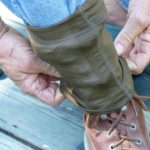
Protect yourself with gaiters
Ticks usually access a person from down near the ground. They’re most likely to cling to pant legs or socks and then walk uphill on the skin. Tucking pants into socks makes life harder for these pesky animals, and we take it one step further. We bought a pair of tick gaiters from Forestry Suppliers, Inc. They cost about $11 and fit over shoes and pant legs, forming a tight seal.
Tick Checks
Doing a “tick check” is important. After being outside take a hot sudsy shower and check the body over for ticks. Fortunately, they usually wander around on the skin for several hours before burrowing in. A tick that has not penetrated the skin won’t spread disease and often is simply washed down the drain. Launder the clothes right away.
Ticks deserve respect. They can spread serious disease and they lurk where people often go. Don’t let a fear of ticks keep you inside. Go outside and play but take precautions to reduce the chances of catching a tick-borne illness.
by Winding Pathways | Jun 10, 2016 | Bugs, Nature, Pests
We are proud of and fortunate that our yard is home to a wide array of fascinating plants and wildlife.
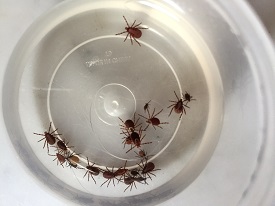
Only a good friend would know that we want pictures of creepy crawlies and save them for us for our blog!
But, last year Rich encountered a wild animal that he wishes he’d avoided. A deer tick found and bit him, although he never saw the tiny eight legged creature. A classic symptom of Lyme Disease is a red rash shaped like a bull’s eye. But Rich never had one. Instead he became overwhelmed with lethargy.
“I never felt sick, just tired, and kept thinking I’d be fine in a day or two,” he said.
But the fatigue dragged on for months, so he called our family physician who urged him to come right in. She gave him a thorough check over, and prescribed a chest X Ray and a Lyme Disease blood test.
Rich did both that afternoon. Within hours the doctor called to say the X ray revealed pneumonia and prescribed an antibiotic. Four days later the Lyme test came back positive and she prescribed a 21 day regime of amoxicillin, a different antibiotic.
“In just a few days the medicine worked and I felt better. Within a month the fatigue evaporated and the only lingering symptom was mild knee pain that may or may not have been caused by Lyme. I’m 66 and have a bit of osteo arthritis,” he said.
Rich was lucky. A year after the Lyme diagnosis he’s doing fine. Fortunately, his doctor prescribed the correct tests and medication and caught the disease early. Many people are less fortunate and suffer long term pain, fatigue and other symptoms.
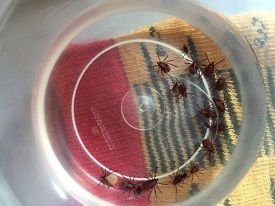
Ticks measured against eighth inch markings.
Lyme disease is transmitted by the deer tick, a tiny eight legged animal that is increasingly common. Ticks live in tall grass and brushy areas, and our yard at Winding Pathways has both. We walk through other places where a tick could have found Rich. Ticks usually crawl around on a person for several hours before digging through the skin and feeding on blood. A wandering tick that has not penetrated the skin cannot transmit disease. Pluck it off and flush it down the toilet or drop it into soapy water.
It’s easy to be scared by negative publicity about Lyme Disease and stay inside. While the disease is serious and is not to be taken lightly, advice to avoid brushy and grassy places must be put into context. These places are beautiful and are homes to interesting wildlife and plants. They are places to get exercise. Even after contracting Lyme we spend part of our time in tick habitat, but we are cautious.
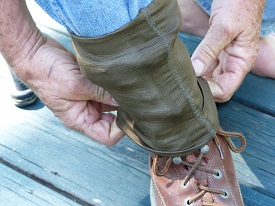
Gaiters fit snugly over boots and pants to deter ticks.
Here’s what we now do:
- Spray our clothes, ankles, and wrists with insect repellent containing DEET.
- When outside for a while we don special tick resistant gaiters (sometimes called spats) that make it hard for a tick to get under pants legs. We bought them from Forestry Suppliers for $13.
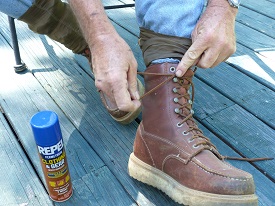
Permethrin-based spray can be bought at most stores that sell insect repellent.
We spray the gaiters with special repellent containing Permethrin that both repels and kills ticks Apply this to clothing, not skin. It is effective for at least two weeks so we don’t launder the gaiters but reapply the spray a couple of times a month.
- Change and launder clothes and shower when we’re done outside. Tiny deer ticks are tough to spot, but we do a body tick check as part of showering.
- Pay attention to our bodies. If we spot a dug-in tick or bulls-eye rash or experience lethargy or joint pain we’ll get to our doctor right away. No procrastination.
Rich emerged from Lyme Disease cautious and smarter but not afraid of being outside in beautiful and interesting places.
FOR MORE INFORMATION
The Internet has great information on ticks and Lyme Disease.
Two of our favorite information sites are:
Centers for Disease Control and Prevention.
WebMD type in the search bar Lyme Disease.
We ordered our tick and chigger gaiters from Forestry Suppliers.
Permethrin based spray can usually be purchased in stores that sell insect repellent. Be sure to read the label.
















